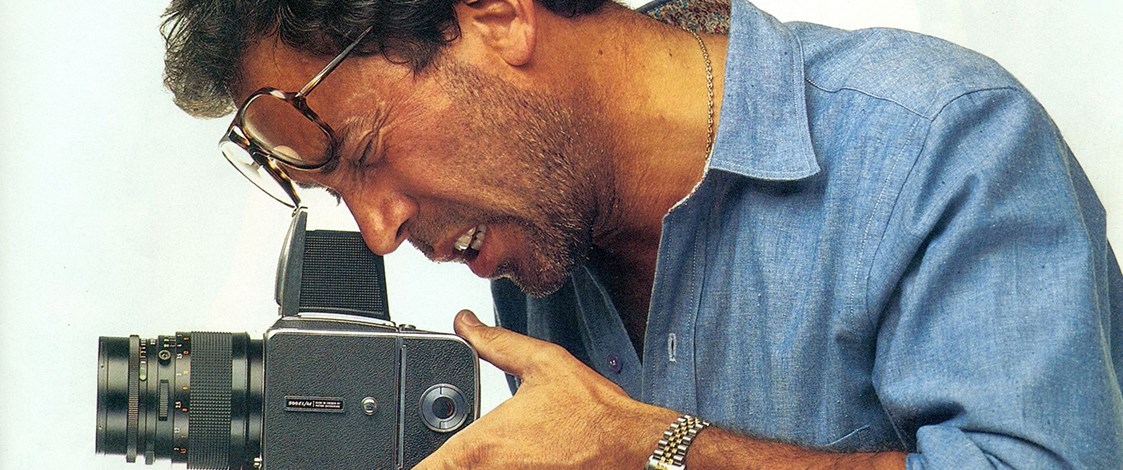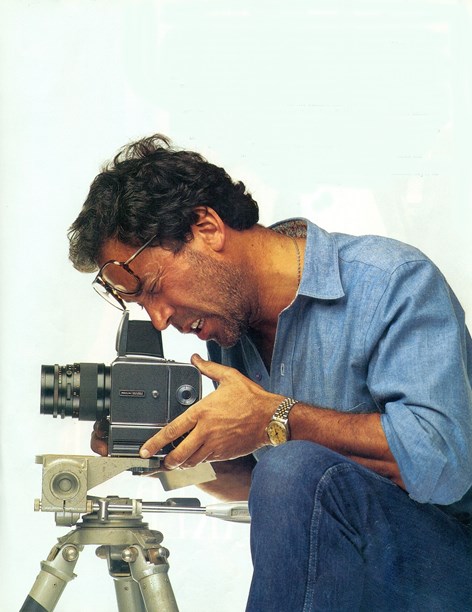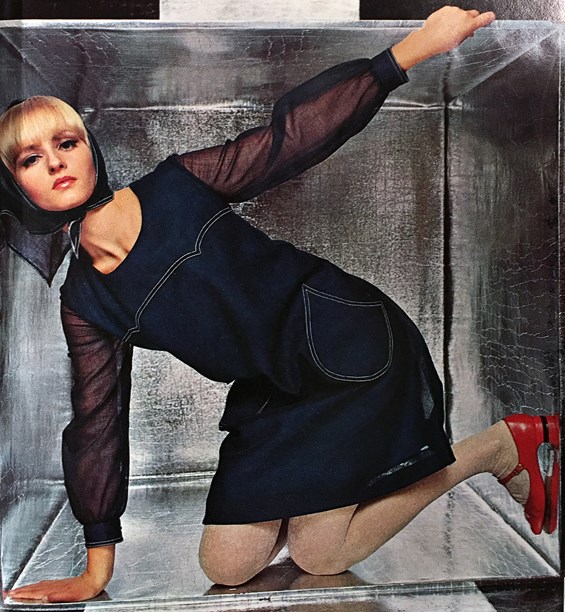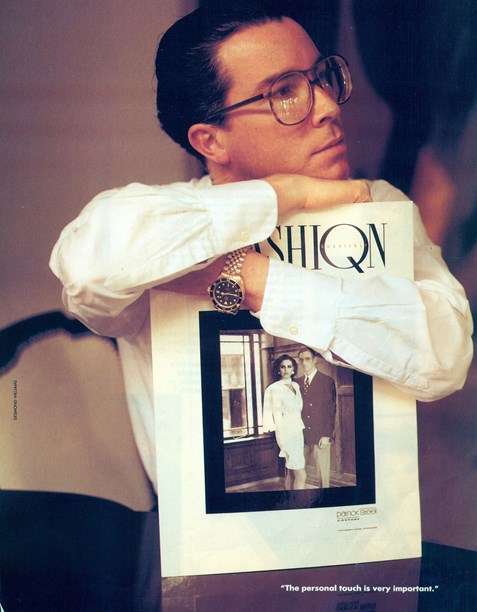Stories
Desmond Williams
1941-

A seminal figure in New Zealand fashion photography from the mid-1960s until the end of the century, Desmond Williams originally intended becoming a graphic designer. But after concluding that "it was quicker to snap it than draw it" (Fashion Quarterly interview 1985), the camera took precedence over pencil and pen.
Born in 1941, and brought up in Lower Hutt, he moved to London in 1959 to study graphic design at the London Central School of Art. He also signed up for a printing and bookbinding course at the London School of Printing and worked part-time as a design assistant to Barry Trengrove, the art director of Harper’s Bazaar.
Although he owned a Pentax camera, and enjoyed shooting London scenes, it wasn’t until a friend asked him to take some pictures of his girlfriend, an aspiring actress, that Desmond considered fashion photography as a career.
He did the rounds of well-known fashion photographers, one of whom, John French, trained 1960s’ stars David Bailey, Brian Duffy and Terence Donovan. Frustrated at not being able to find a job, he moved to Dublin and set up a studio there. His first assignment was for the Irish Wool Board, shooting Irish couture on top English models. A chance meeting with Terence Donovan, in Ireland for an Aer Lingus (Irish Airlines) shoot, led to a job as his temporary assistant and an offer of permanent employment in London.
In the time he spent assisting Terence Donovan, Desmond honed his photographic skills, moving on after 12 months for a brief stint in New York before returning to London as a freelancer at a studio complex called Studio Place. His assignments there included fashion shoots for Women’s Day and Good Housekeeping. He also covered the Paris collections.
Back in this country in 1966, Desmond found work with Auckland photographer Doug Vahry before branching out on his own. Fully conversant with the London vibe, he quickly made his mark. Along with fellow Aucklanders Bob Harvey (advertising), Roger Donaldson (then doing fashion stills) and art director John Buckley, he helped change the face of New Zealand fashion and advertising photography from formalised and aloof to exuberant, fresh and young.
Sal Criscillo, a member of Studio 57, a professional photographers’ group Desmond joined on his return, remembers the 1960s’ scene: "Young local photographers were starting to develop an awareness of fashion as portrayed in English and American magazines. They were looking at model poses, lighting and so on and Des was a big part of that. What others were reading about, he did. He was a fine technician as well as a talented creative and he had all the latest equipment. He used a Hasselblad (large format camera) and was the first in New Zealand to have Balcar flash units. When it came to implementing new photographic techniques, again Des was always two steps ahead."

Desmond Williams behind the lens. Fashion Quarterly, Autumn 1990. Image © Desmond Williams.
An example of his innovative approach is the set of images he produced for a New Zealand Wool Board campaign in the 1960s. It involved exposing a negative three times to compile three images in one shot, complete with over-lapping ghosting effects where one garment hem crossed another.
A number of young photographers, who went on to have successful careers, got their start in Desmond’s studio. While assisting Desmond, Philip Peacocke observed the classical system of preparing a shoot, doing the shoot and printing the shot, that Desmond inherited from a lineage of classical British photographers. "He brought back with him the secret film and printing formulas and chemistry that produced some of the great shots of that period in history."
In addition to creating advertising images for major clients like the New Zealand Wool Board, Desmond also produced model portfolios, promotional material for fashion designers and manufacturers, such as Miss Deb and Expozay, and innumerable fashion shoots and portraits for magazines.
Throughout the 1980s, Desmond Williams work appeared regularly in Fashion Quarterly.
He was one of the first local photographers to contribute to Vogue New Zealand. Prior to then, the clothes were sent to Australia to be photographed. "We would all prostitute ourselves for Vogue," he told Sandra Peacocke in ChaCha in 1985, "even if they paid us tuppence."

Jonathan Logan dress photographed by Desmond Williams for Vogue New Zealand, Spring 1966. Image © The Condé Nast Publications Ltd.
Michal McKay, Vogue New Zealand’s former fashion and beauty editor, recalls working with Desmond. "Des was a force to be reckoned with, always talking at a hundred miles a minute and at a very high decibel. His commentary during a shoot was non-stop – 'not sure about that bow Michal – isn’t that a dip in the hem at the back? – the hair doesn’t do it for me – wow, that’s fabulous' – all delivered at shot-gun pace. He had no hesitation about making his opinions felt but he always produced the goods. His photography was exceptional, his eye for anything that would make a beautiful shot, faultless."
In the early days, Desmond didn’t work with model agencies unless a client requested a particular model. He went out and found his own. Three of his first discoveries were the Overton sisters, Stephanie and Vicki, and 15-year-old schoolgirl Judith Seay (later Baragwanath), all of whom he shot for Vogue. He took great care to ensure that his protégés’ make-up, hair and 'look' were just right and it didn’t take long before they were appearing in editorials and on the covers of the leading magazines of the day. Twenty years later, he was still picking winners, most notably Rachel Hunter who he photographed for Fashion Quarterly in 1986, effectively kick-starting her modelling career.
Desmond was also one of the photographers who made Eve magazine (1966-1975) swing. Less risk-averse than Vogue New Zealand, Eve encouraged its photographers to come up with bold ideas. Although not a fashion magazine per se, Eve had a strong fashion presence. Several pages were devoted to fashion in every issue and, each year, it staged its own fashion awards.
Some of the finest examples of Desmond’s fashion editorials and portraits, dating from 1980 to the late Nineties, can be found in Fashion Quarterly. His perfectionism matched that of the magazine’s editor Paula Ryan and together they created many memorable images in New Zealand and in locations overseas. "Not only was Desmond one of the most technically advanced photographers in the country," says Paula, "he had a brilliant eye for composition and balance and his enthusiasm and passion were well beyond the norm."

Fashion Quarterly editor Paula Ryan photographed by Desmond Williams for a feature in the magazine in 1995. She is wearing a velvet suit and feather hat by Patrick Steel Couture.
Desmond never objectified women. He could always be relied upon to bring out the best in his subjects, whatever the clothes, the pose or the location. In a Fashion Quarterly interview in 1990 he said he liked the women he photographed to be in control but softly in control, sometimes a little assertive but not in a confrontational way.

Photographed by Desmond Williams in her Remuera home with her son Campbell, Stephanie Myers (nee Overton) who Desmond first shot for Vogue New Zealand in the 1960s, wears an evening gown by Adrienne Winkelmann. Fashion Quarterly, Winter 1987.
A competent make-up artist, he often made up the faces of the models for his own shoots and for other fashion events. When Patrick Steel presented his debut collection in a spectacular show, viewed by 600 guests at the Auckland War Memorial Museum in 1985, he chose Desmond to do the make-up.

Designer Patrick Steel poses for Desmond Williams in his Parnell boutique. Fashion Quarterly, Autumn 1990.
From the mid-1970s until the end of the 1990s, when he went to live in Australia, Desmond divided his time between fashion and advertising assignments in Auckland, Sydney and London. In Auckland, he worked for a time from Team Studio in Khyber Pass and, in London, hired a studio when he needed one. In 1985, he was commissioned to shoot catalogues for Jaegar and Simpsons of Piccadilly, both prestigious names in British fashion at that time.
After moving to Australia, his fashion days behind him, Desmond worked with the internationally acclaimed, Las Vegas-based Australian photographer Peter Lik, best known for his nature and panoramic landscape images. When Michal McKay was appointed Editorial Director of Fairfax Magazines in 2005, he did photo shoots, on her behalf, for New Zealand House & Garden.
Voluble, volatile, often referred to as a walking encyclopaedia of photography and, in terms of his ability, as New Zealand’s answer to David Bailey, Desmond Williams presently resides in northern Australia where, in his own words, he "lives life peacefully in the sun".
Text by Cecilie Geary. Banner image of Desmond Williams behind the lens from Fashion Quarterly, Autumn 1990.
Last published April 2017.